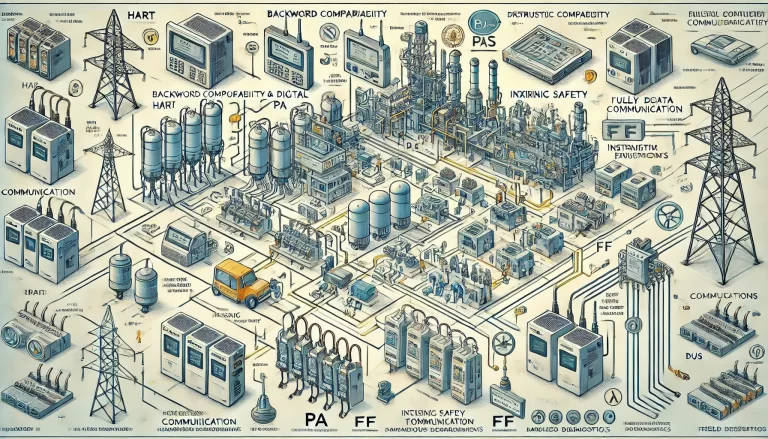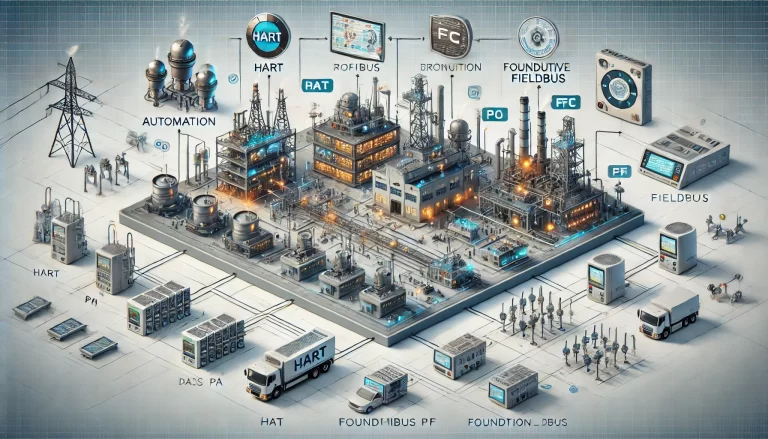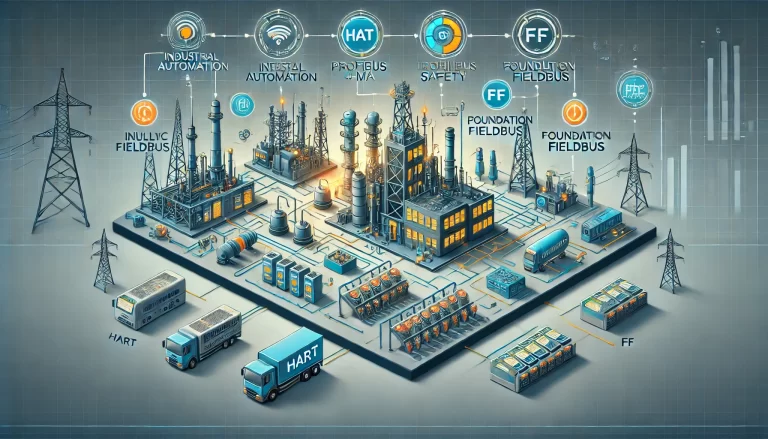In the field of industrial automation and process control, communication between field devices (such as sensors and actuators) and control systems (like DCS or PLC) is essential. Several protocols have been developed to facilitate this communication, with HART, PA, and FF being among the most widely used. Each of these protocols has distinct features and applications that suit various industrial environments. Let’s explore them in detail.

1. HART (Highway Addressable Remote Transducer) Protocol
HART is a widely adopted communication protocol that allows the simultaneous transmission of both analog and digital signals over the same wiring.
- How It Works: HART uses a 4-20mA current loop, a standard in analog signal transmission, to transmit the primary variable, while a high-frequency digital signal is superimposed onto the analog signal. This allows two-way communication between the field devices and the control system.
- Advantages:
- Compatibility: HART devices are backward-compatible with traditional 4-20mA systems, making them ideal for upgrading existing systems without significant infrastructure changes.
- Bidirectional Communication: Not only can devices send measurement data, but they can also receive commands for configuration or diagnostics.
- Widespread Use: HART is commonly used in sensor and transmitter communication for remote configuration and health monitoring.
- Disadvantages:
- The data transfer rate is relatively slow, typically around 1.2 kbps, which may not be sufficient for applications requiring high-speed data transfer.

2. PA (Profibus PA) Protocol
PA (Process Automation) is a variant of the Profibus protocol, tailored specifically for use in process automation environments. It supports the digital transmission of data between field devices and control systems.
- How It Works: PA is a bus-based communication protocol that transmits digital signals, allowing data transfer as well as device power supply through a single cable.
- Advantages:
- Intrinsic Safety: PA is designed to be intrinsically safe, making it suitable for use in hazardous environments where safety is a primary concern.
- Unified Power and Data Transmission: Devices can be powered and communicate data using the same wiring, simplifying installation and reducing cabling costs.
- Digital Communication: PA offers better performance than analog systems, allowing for more detailed diagnostics and control.
- Disadvantages:
- The transmission speed is relatively slow (typically 31.25 kbps), which limits its application in scenarios requiring high-speed data transfer.
- The implementation of PA requires specialized gateways and infrastructure, making it more complex than analog or hybrid systems like HART.
3. FF (Foundation Fieldbus) Protocol
Foundation Fieldbus (FF) is a fully digital communication protocol designed specifically for process automation. It enables a distributed control system where field devices can communicate with each other without relying on a central controller.
- How It Works: FF uses a digital communication system where multiple devices can connect on the same bus network, sharing information digitally. There are two types of FF: H1 (operates at 31.25 kbps and is used for device-level communication) and HSE (High-Speed Ethernet, operates at 100 Mbps, used for communication between controllers and higher-level systems).
- Advantages:
- Full Digital Transmission: FF eliminates the need for analog signals, providing more accurate and detailed data, as well as additional diagnostic information from field devices.
- Interoperability: Devices from different manufacturers can easily be integrated within the same FF network, promoting flexibility and vendor independence.
- Distributed Control: FF supports executing control logic within the field devices themselves, reducing the load on central controllers and improving system reliability.
- Disadvantages:
- The H1 protocol has a low data transfer rate, which may not be sufficient for high-speed applications.
- FF networks are relatively complex to install and maintain, and they often require specialized training and tools.

Conclusion
- HART is ideal for hybrid analog-digital systems, offering backward compatibility with existing 4-20mA systems and basic digital communication.
- PA is suited for hazardous environments, providing intrinsic safety and integrating power and communication in a single cable.
- FF is the most advanced of the three, offering a fully digital communication platform with distributed control capabilities, but it requires more complex infrastructure and training.
Choosing the right communication protocol depends on the specific requirements of the industrial process, such as safety needs, data transmission speed, system complexity, and compatibility with existing infrastructure. Each protocol plays a key role in optimizing communication and control in process automation systems.
